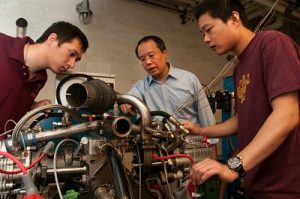Starting July 1, Professor Zongxuan Sun from the University of Minnesota will head the Center for Compact and Efficient Fluid Power. We recently spoke with Prof. Sun about CCEFP’s continuing focus on research, education and advancing fluid power technology. He also touched on efforts to expand research funding from the federal government and private industry (“Incoming director shares CCEFP vision”). Here’s Part 2 of our interview.
FPW: In addition to increasing funding for the Center, would you like to increase the number of universities involved in research?
Professor Sun: Yes. When CCEFP started we had seven member universities and later we increased to 10 universities. More recently, we decided that our proposals are open to any U.S. university. So when we fund a research project, we are not limiting which universities can participate, as long as they are within the United States.
FPW: Do you envision the Center working with universities and research centers outside the U.S.?
Professor Sun: We already have academic exchanges with universities and fluid power centers across the world. That relationship has already been built. For academic exchanges, for visiting students, visiting scholars, we have already developed a very strong strategic relationship with universities and research centers in both Europe and Asia. In fact, our researchers already participate in many of the conferences that are hosted by the European and Asian research centers for fluid power.
FPW: When you take over as the Center’s director, will you have to reduce your schedule at the University of Minnesota in terms of teaching and research?
Professor Sun: That’s a great question. I do not plan to reduce my research. Instead, personally, I plan to continue to maintain and grow my research portfolio because that is the key part of training graduate students and preparing talents for the industry.
For teaching, the typical arrangement for the director of the CCEFP, or of any large research center, is usually to have a reduced teaching load. I personally really enjoy teaching and interacting with both undergraduate and graduate students and, not to brag, but I have won several teaching awards from the University. So, yes I will continue to teach, but fewer classes, to spend more time on administration and strategic direction of the Center.
FPW: And one final question, what keeps you awake at night? Are there any significant challenges you will face when you become the Director of the Center?
Professor Sun: Yes, I think the biggest challenge is we have to continuously figure out the best approach to bring industry and researchers together, and to find the resources to maximize our research activities and the training of students.
The reason I’m saying this is that before I joined the University of Minnesota, I worked at General Motors. A lot of my research, even today, is closely related to power train and propulsion for on-road, but also now, with off-road vehicles. As you can imagine, I naturally would sometimes benchmark the activity we have for fluid power off-road against on-road activity. When you look at the investment and number of people devoted to on-road transportation, it is much greater than that for the fluid power off-road segment. But I also feel that the technical challenge in off-road is as complex and, in certain areas, even more complex.
Let me give you an example. The cars we drive every day are one-input, one-output systems, where the input is mainly an internal combustion engine. (Of course, there are also hybrid and electric vehicles.) And the output is basically torque to the wheels that drive the car. And in between we have the transmission. But that’s basically the structure of power generation and transmission that makes up the power train today.
If you look at off-road vehicles, again you have to generate power, most of the time with an internal combustion engine, although people are also looking at hybrid and even electrical solutions. But now you have to transmit the power to the vehicle with two or more destinations, rather than just one. I call it a one input, multiple output system.
That’s because part of your output is needed to drive the vehicle, and part of the power goes to the working circuit. And there is a lot of diversity among off-road vehicles, depending on the type, that perform all kinds of digging, lifting and transporting functions. So basically, from power generation to power transmission to the usage of that power, everything gets more complex.
And compared to cars, the market volume is low. All of these issues make the technology solutions much more difficult. That’s really my focus, to come up with efficient ways to integrate researchers with our industry members to tackle those difficult technical problems.
CCEFP
www.ccefp.org
Filed Under: News
